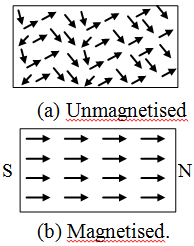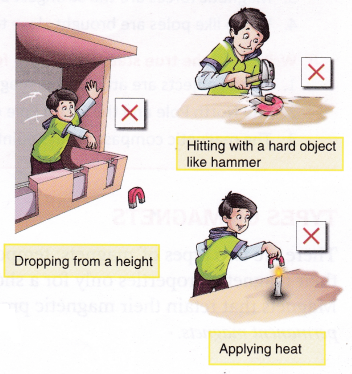What are the Different Types of Magnets?
- Magnetism: The property due to which a substance attracts iron pieces towards it, is called magnetism.
The substance having property of magnetism, is called magnet. - There are two types of magnets: temporary and permanent.
- Magnets that retain their magnetic properties only for a short period of time are called temporary magnets.
- Magnets that retain their magnetic properties for a long period of time are called permanent magnets.
- Temporary magnets are usually made of iron, cobalt, or nickel. These materials behave like magnets only when they are near a strong magnet. They quickly lose their magnetic property if the influence of the strong magnet is removed.
- Permanent magnets are made from mixtures of iron, cobalt, or nickel with other materials. These make strong magnets and retain their magnetic properties for a long time.
1. Permanent (Natural & Artificial magnets)
Natural magnets: Pieces of naturally occurring iron ore lode–stone or magnetic or black iron oxide (Fe2O3), are called natural magnets.
Properties: These have following two properties.
- Attractive property: They attract small iron pieces towards them.
- Directive property: When suspended freely, their ends would point in geographical north–south direction. For this reason, the suspended piece is called lode stone or leading stone.
Disadvantages: These have following two demerits:
- They have irregular shape.
- They are weak.
Artificial Magnets: These magnets are made of hard steel or special alloys. The substances of these magnets have many small ‘atomic’ magnets. Ordinarily they are all oriented in random directions (Fig.). Then the substance is unmagnetised.

When such a piece is put in North–South direction and hammered, the atomic magnets align themselves in the direction of the earth’s field fig. They retain this alignment and the piece becomes a magnet with North (N) and (S) pole near ends. This magnet with two poles, is called a magnetic dipole.
Advantages: These have following two merits
- They may be given desired regular shape.
- They are strong.
2. Electromagnets
Electromagnets are based on the magnetic effect of electric current. An electromagnet is usually prepared by placing a soft iron core in a solenoid, or by winding a large number of turns of an insulated wire (generally the insulated copper wire) on a cylindrical soft iron core. An electromagnet shows magnetic properties only as long as the electric current flows through the solenoid. Thus, electromagnets are temporary magnets.
People also ask
- Who discovered the magnet?
- How does a magnet work?
- Is an electromagnet a temporary or a permanent magnet?
- What is the use of magnet?
- How does an electric bell work using electromagnets?
- What is the Magnetic Field?
- Factors Affecting the Magnitude of the Force on a Current-carrying Conductor
- What is magnetic force on a current carrying conductor?
- What factors affect the strength of an electromagnet?
- How does a current carrying conductor produces a magnetic field?
- What Is Magnetic Effect Of Electric Current?
- Oersted Experiment on Magnetic Effect of Current
- How do you Determine the Direction of the Magnetic Field?
- What is the Meaning of Magnetic Force?
What is the difference between a temporary and a permanent magnet?
Electromagnet
Nature of magnetism: Temporary. An electromagnet shows magnetism only as long as current flows through it.
Polarity: The polarity of an electromagnet can be changed by reversing the direction of the current.
Strength: The strength of an electromagnet can be increased or decreased by increasing or decreasing the current.
Permanent magnet (or Bar magnet)
Nature of magnetism: Permanent (or bar) magnets show permanent magnetism.
Polarity: Polarity of a permanent magnet cannot be changed.
Strength: The strength of a permanent magnet cannot be changed.
Poles of a magnet: When ends of a magnet are dipped in iron filings, the filings stick to its ends only and not to its sides. It means that in magnets, centres of attraction are located near ends only. These centres of attraction near the ends of a magnet are called poles.
When this magnet is freely suspended, the two ends point in north–south direction. The pole near the end pointing towards North (north–seeking end) is called North pole. The pole near the end pointing towards South (south–seeking end) is called South pole.
Interaction between poles: The magnetic poles exert forces on each other. Like pole repel each other, i.e., one north pole will repel another north pole or unlike poles attract each other i.e., north pole attract south pole.
Activity
Aim: To make a magnet
Materials needed: A (steel/iron) needle, a magnetic compass, small pins (made of iron) and a bar magnet
Method:
- Place the needle on a table.
- Rub the magnet along the length of the needle, starting from one end of the needle (end A). When you reach the other end of the needle, lift the magnet and start again at end A.
- Repeat the process many times.
- Keep the bar magnet away and bring a magnetic compass near the needle. See if it deflects the compass needle. If it does not, repeat Step 2. If it does, your needle has now been magnetized.
- Bring the needle close to some iron pins.
They will be attracted to your newly made magnet.

Observation: The iron pins will get attracted to the needle.
CARE OF MAGNETS
A magnet can lose its properties due to the following activities.
- Dropping from a height
- Hitting with a hammer
- Applying heat
- Improper storage can also cause loss of magnetic properties.

Bar magnets should be stored in pairs, with Dropping from a height unlike poles alongside each other. A horseshoe magnet should be stored with a piece of soft iron kept across its poles.
